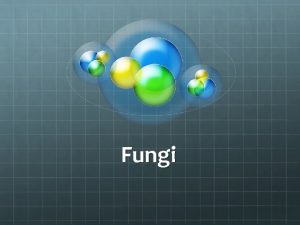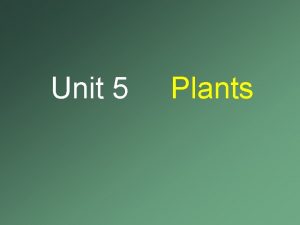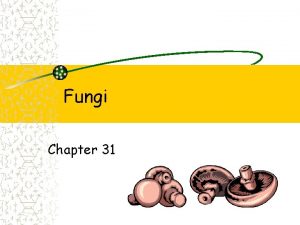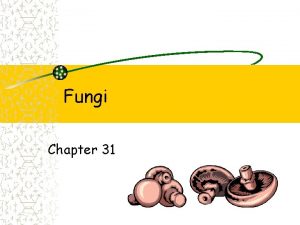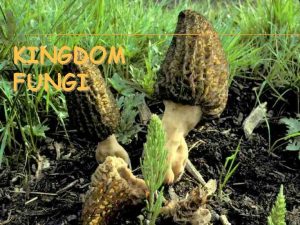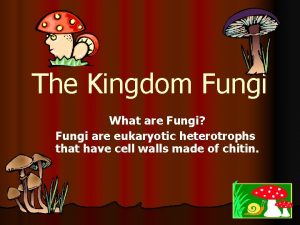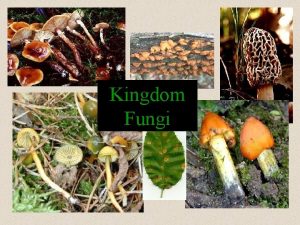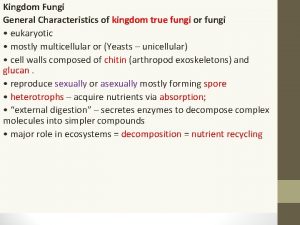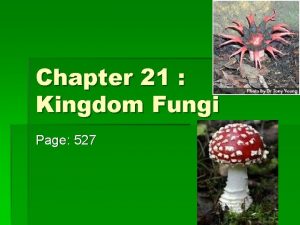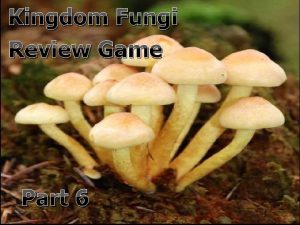Kingdom Fungi Fungi are NOT Plants Fungi are














- Slides: 14

Kingdom Fungi

Fungi are NOT Plants Fungi are not plants because they do not photosynthesize (no chloroplasts present)

All FUNGI have six characteristics in common: 1. 2. 3. 4. 5. 6. Often have many nuclei per cell Heterotrophic Have few or no storage molecules Don’t have roots Often have chitin in their cell walls Don’t reproduce by seed

Fungi Characteristics • Most are multicellular (except for yeast which is unicellular) Fungi tend to spread out over large areas • Fungi exist in dark, warm, moist locations that are rich in organic matter – Forest floors – Banks of rivers/streams • Most fungi are terrestrial, some are aquatic • Stationary; do not move – Fungi don’t have roots – instead they use their hyphae

Fungi Hyphae & Mycelium How do fungi obtain nutrients? • Hyphae = long thread-like cells that branch out over long distances to collect nutrients – Multiple hyphae interlock and criss-cross in a mesh to form mycelium • Fungi digestion is extracellular… nutrients are digested externally before being absorbed by the mycelium


Fungi Reproduction • Reproduce both sexually and asexually – Sexually: Produce spores (reproductive cells) that are produced in the sporangium • Spores are dispersed by air currents (wind) – Asexually: Pieces of the mycelium break off, growing new fungi (this is called fragmentation)

Connection to Human Disease • Ringworm – Microsporum • Highly contagious • Spreads rapidly if not treated • Also causes Athlete’s Foot (shower floors, running shoes) – Treatable with a fungicide spray/powder/pill

Connection to Human Disease • Poisoning – Amanita • Caused by ingestion of highly poisonous mushrooms • Toxins enter the blood stream • Ingestion leads to abdominal pain, cramps, vomiting, death • Can also affect the nervous system, causing hallucinations and behaviour similar to drunkenness (coma and death may result from these neurotoxins) – Often treatable with stomach pumping (before toxins pollute the blood stream)

General Importance of Fungi • Fungi act as: – Decomposers – Source of yeast to make bread, wine, beer – Source of mould to make penicillin – Soft drink flavouring – Source of food (mushrooms, morels, truffles)

Importance of Fungi FOR PLANTS • Many fungi are involved in a symbiotic relationship with plants – Symbiotic Relationship: a relationship between two organisms in which both partners benefit from the interaction • Mycorrhizae = extensive fungal networks that help the roots of plants absorb nutrients; in return the fungi receives sugars that the plant as made during photosynthesis

Microorganisms in Ecosystems

In nature, there are three types of symbiotic relationship: • Mutualism: – Both organisms benefit – (+ / +) relationship • Commensalism: – One organisms benefits, the other is unaffected – (+ / 0) relationship • Parasitism: – One organism (parasite) benefits at the expense of another organism (host) (the host is usually harmed, not often killed) – (+ / -) relationship

 Mikael ferm
Mikael ferm Old kingdom middle kingdom new kingdom
Old kingdom middle kingdom new kingdom Nnn ruled
Nnn ruled Old kingdom middle kingdom new kingdom
Old kingdom middle kingdom new kingdom Capital of egypt during the old kingdom
Capital of egypt during the old kingdom Protista mobility
Protista mobility Plantae
Plantae Protista
Protista Fungi are not considered plants because
Fungi are not considered plants because Not genuine not true not valid
Not genuine not true not valid Trichomoniasis
Trichomoniasis 5 characteristics of plants.
5 characteristics of plants. Fern is vascular or nonvascular
Fern is vascular or nonvascular Nonvascular plant diagram
Nonvascular plant diagram Non flowering plants characteristics
Non flowering plants characteristics








